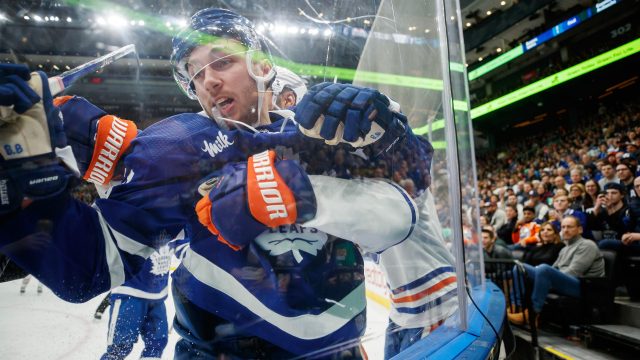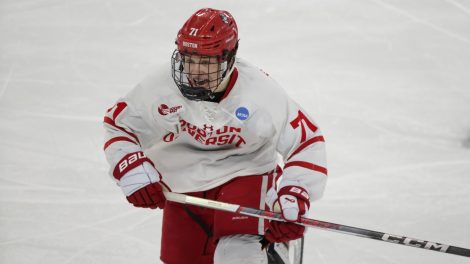TORONTO – Sheldon Keefe, by nature, is a tinkerer.
The whiteboard is his beaker, coloured Sharpies his elixirs.
Part chemist, part coach, the man shouting surnames behind the Toronto Maple Leafs bench has been blessed — or, depending on your love for stability, cursed — with the gift of time.
Try as one might to sell the importance of the Maple Leafs’ remaining 16 games, in these quarters, the results matter less than the learning.
Even with Monday’s lacklustre 4-3 collapse to a desperate Buffalo Sabres club, the Leafs are the NHL’s fourth-best club. They are up four points (plus a game in hand) on a first-round opponent, the Tampa Bay Lighting, that they’ve known about for months and are an 88 per cent lock as the Atlantic Division’s No. 2 seed, per MoneyPuck.com.
It’s no secret they’ve hit cruise control, and with little reason to be urgent until mid-April, it would be hard to blame them.
True, they haven’t embarked on so much as a four-game win streak since the first half of November. But they also haven’t lost consecutive outings since Jan. 14, and they’ve only hit a losing skid longer than two games once — way back in October, when they dropped four on the road and the sky was falling.
That was eight trades ago.
Feels like a lifetime ago.
Frustrating as it might be for the ticket-buying public who invest in a sluggish effort, these Leafs now know when to slam the gas and when to idle the engine for the big race.
Which brings us back to Keefe, who wants to test-drive every model in the lot before committing to his ride.
“We’re trying to put our players in the best spot possible to win every game while also having an eye towards what’s coming,” Keefe said after Monday’s blown lead. “Whether that’s trying different things that you may want to look at in certain times, or sometimes maybe you have to (change a line).
“Different things happen that you may want to get ahead of.”
Keefe tugs at the memory of his undisputed top line from 2021-22 — Michael Bunting–Auston Matthews–Mitch Marner — tearing through the league … until Bunting suffered an injury shortly before the Lightning series and was not nearly as effectual.
“So, we are certainly trying some things that are with an eye towards scenarios that might happen,” Keefe said.
If Bunting goes down or Matthew Knies can’t become an overnight NHLer, Alexander Kerfoot can jump up. If Matthews and Marner stop clicking, Marner can reunite with John Tavares. We already know Nylander can find a hot stretch with Matthews. Before Ryan O’Reilly’s busted finger, he too had made the rounds with a slew of top-nine wingers.
GM Kyle Dubas seemingly brought in power-play specialist Erik Gustafsson as Toronto’s seventh (eighth?) defenceman at the deadline in event that injuries pile up or the special teams hit a major rut.
Keefe wants everyone to feel comfortable skating alongside everyone else. Just in case.
The coach has been burnt so often by the unexpected (see: alarming postseason injuries to Tavares and Jake Muzzin, twice) that he’s now running repeated fire drills in anticipation of the next blaze. Because he is hyperaware the next implosion will cause the whole room to go up in smoke.
Only time will tell, of course, if all this line-juggling and partner-swapping results in a nimbler lineup when the inevitable curveballs of do-or-die hockey start flinging the Leafs’ way.
Or: Is there some measure of overthought or overpreparation going on? Could this lack of repetition and rhythm on the bench be detracting from a more singular plan?
Surely there is an end date (say, April 1?) to Keefe’s fact-finding mission, a point in the regular season where he starts dress-rehearsing his Game 83 lineup.
The buzzy topic these days is Toronto’s 11-forward, seven-defenceman deployment, an approach Keefe himself described as “not Option A” but has been warming to.
“We’ve played some of our best hockey with 11 and 7,” Keefe said, pointing to wins over Calgary and Edmonton.
The positives:
• Guards against an in-game injury or misconduct to a defenceman.
• Prevents a bubble D-man such as Timothy Liljegren, Luke Schenn or Gustafsson from getting discouraged by frequent healthy scratches. The new D are getting acclimatized and feeling engaged.
• Opens more ice time for superstar forwards. Matthews (23:20), Marner (22:30), Nylander (22:24), and Tavares (19:40) all skated more than Keefe’s most-used defenceman, Morgan Rielly (18:34) Monday.
• Keefe hasn’t been using his 12th forward — right now, that’s Alex Steeves — much anyway. “Especially with the O’Reilly injury, it’s a lot easier for us to play seven,” he said.
• Can throw the opposition off-guard.
“When the other team is trying to match your rhythm with their D pairs and their matchups, you can really mess with that a little bit. They’re not quite sure what’s coming next,” Keefe explained.
“While 12 and 6 is the most comfortable situation, it might not be the best one.”
The negatives:
• Risk. What if a forward gets hurt in-game, as O’Reilly did during the Leafs’ loss in Vancouver? On that night, Keefe’s forwards were so exhausted, he considered throwing one of his extra D-men on wing.
• Places extra stress on the coaches to adjust on the fly. Instead of simply yelling, “Matthews Line!” Keefe must call out all three names. He must monitor ice times and fatigue levels of individuals more closely.
• Games with plenty of special-teams action complicate rhythm even more. The in-the-moment evaluation can be a load to handle.
“What I found is you have a plan going into it, but you really have to respond to what’s happening in the game,” Keefe said.
• Players can get lost in their heads, not the game.
Tyler Johnson put it nicely when Jon Cooper began using 11/7 in Tampa Bay Lightning’s early playoff runs, a strategy that would later aid in a couple of Cups:
“The chemistry is always different. I’m still trying to figure out what to expect and what to do. It’s hard to build on anything because it’s always somebody different. But the team is playing well right now, so we got to keep on going.”
Ironically, it is the organization Keefe is ultimately trying to outsmart that popularized 11/7 in this era.
Our bet: When O’Reilly is healthy, Knies signs and the postseason comes into sight, Keefe reverts to the more familiar 12/6.
But, hey, 11/7 will just be one more experiment checked off the list, another tool in his deep trove of combinations, and one less surprise to throw at his players.
“In terms of staying with it, I thought we wouldn’t do that,” Keefe said. “But after processing some things, it’s important to keep our depth on defense involved and engaged.
“We might discover through this we just might be better at 11 and 7. Look at how things have gone for us as of late, and you can see some of the positives coming out of it. I think it’s important we’re not just locked in to 12 and 6.”
Fox’s Fast 5
• A microphone malfunction prevented anthem singer Natalie Morris from belting out “The Star-Spangled Banner” before puck drop.
A rink full of Canadians stepped in to sing it for her.
“I’m really glad you mentioned that,” Sabres coach Don Granato said. “That was a pretty special moment — to be in Canada and hear the crowd singing our anthem. So, hats off to the fans that were here. I think that will be a memorable thing for anyone who’s in the building. What a great place this is. Lots of great people. And they rose to the occasion.”
“Everybody coming together, it’s pretty cool to see that in any building, but obviously when you’re in Toronto and it’s the American anthem,” American Auston Matthews agreed. “That was a really cool gesture by everyone.”
• With his club’s defensive performance stumbling and focus slipping, Granato healthy-scratched Victor Olofsson — he of a career-high 24 goals but also a minus-22 — for the first time this season.
• Leafs Nation has always loved its hard-hitting, blue-collar grinders.
Fourth-liner Noel “Cookie” Acciari was greeted Saturday at Scotiabank Arena with a fan-made sign showing support for No. 52 alongside a drawing of Cookie Monster.
“It’s awesome. They accept my love for cookies, and it’s showing out there,” Acciari said.
Added Keefe: “It’s a great nickname. You don’t get too many of those.”
(The Maple Leafs are also happy to call Ryan O’Reilly by his nickname, “Factor,” to avoid any O’Reilly/Rielly confusion.)
• Sabres fans are officially on Devon Levi watch.
With Levi’s college season in Providence over, the 21-year-old prospect can sign his entry-level contract whenever he wishes.
In 66 career NCAA games, Levi posted a 38-22-6 record, with a 1.90 goals-against average and 16 shutouts.
Levi’s .942 save percentage is the second-best career mark in men’s college hockey history.
Only Connor Hellebuyck (.946), who played eight fewer games, was better. He turned out OK.
• Luke Schenn, proud father of three, is back in Toronto and could play a home game as early as Wednesday.
Acciari’s wife and their two young children also made the move Monday. Finally. It took a couple weeks to sort out a passport for 11-month-old daughter Sutton.
“I’ve definitely missed them,” he said. “Knowing they’re coming today is exciting.”











